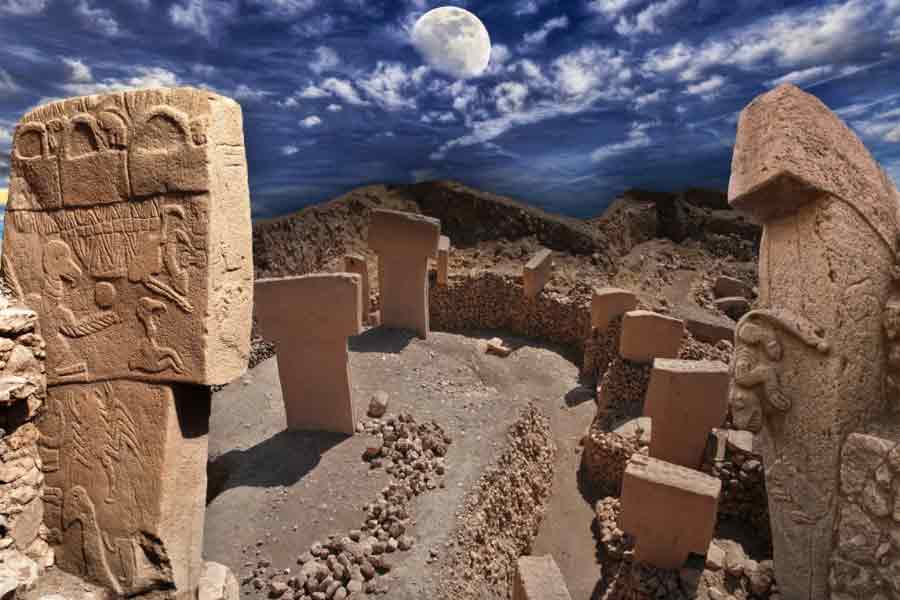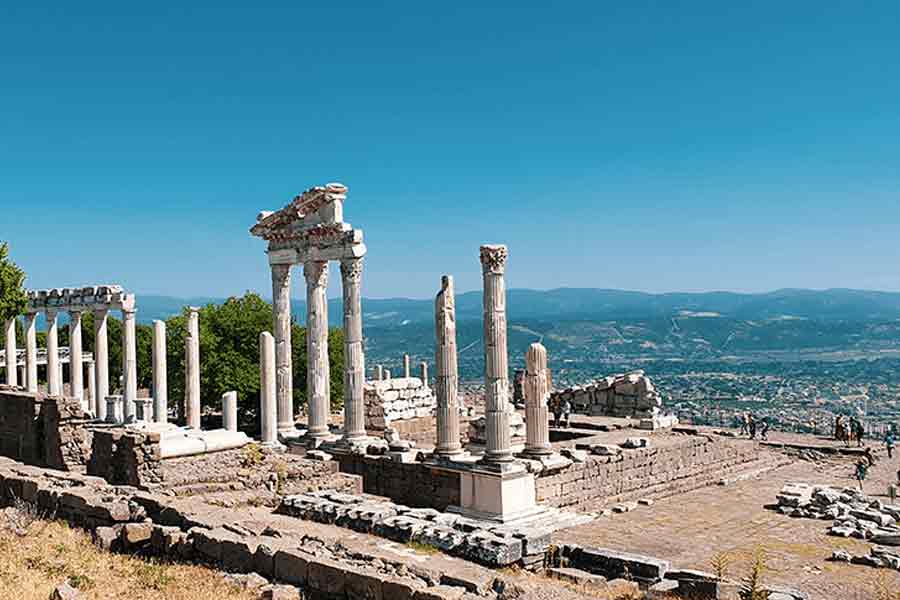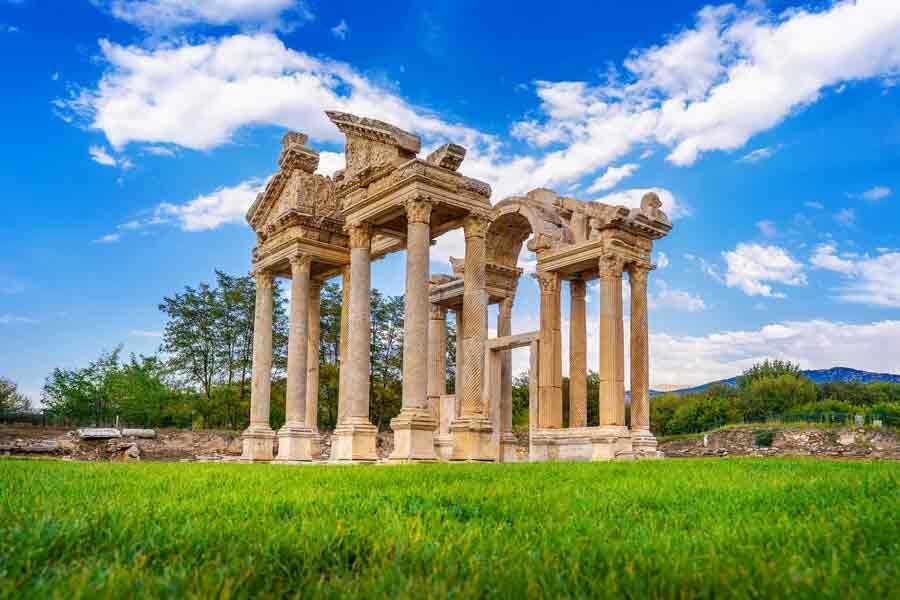From classical cities scattered along the coast to archaeological sites that date back to the earliest periods of human history, Turkey's fertile plains, high steppe and rugged mountains have witnessed every stage on the human journey.
Even if you’re planning a beach break, don’t miss brushing up on some of this remarkable heritage while you're here. These are the best ancient sites in Turkey.
What is more, the majority of the ancient ruins in Turkey remain in very good condition.
There are in total 28 archaeological sites in Turkey that attract a large number of international visitors every year. The most important ancient sites in Turkey are: Göbekli Tepe, Ephesus, Temple of Artemis, Bergama Acropolis, and Aphrodisias.
Turkey is one of the key destinations of archaeology located in the South West of the Asian continent which covers Mesopotamia, the birthplace of civilizations, tamed animals, and plants. Right after the appearance of the first mass production of food sources, humans started founding villages, towns, cities, and countries. Here we list some of the most famous, must-visit archaeological sites of Turkey.
 1. Göbeklitepe- Şanlıurfa
1. Göbeklitepe- Şanlıurfa
A Neolithic sanctuary near Şanlıurfa, experts believe that Göbeklitepe is one of the oldest man-made religious structures. The limestone pillars that stand on the top of a mountain ridge are decorated with reliefs of animals and abstract pictograms.
2. Hattusha, Çorum
The Hittite Capital of Hattusha is one of the most important open-air museums in Anatolia, located in the Boğazkale district of Çorum. This important settlement, which served as the capital of the Hittite Empire for centuries, entered the UNESCO World Heritage List in 1986. Hattusha displays examples of the advanced art and architecture of the Hittite Civilization to its visitors. Most of the monuments that can be seen in the city belong to the great reconstruction period in the 13th century BC. The city walls, the King's Gate, the Lower City, the Upper City, the Great Palace where the kings resided and temples are just some of the magnificent structures you can see in Hattusha.
3. Ancient city of Ephesus- İzmir
The ancient city of Ephesus, which is on the UNESCO’s World Heritage List, one of the landmarks of Izmir located in the Selçuk district, is one of the most important centers of the ancient period. It is a crucial port city and cultural and commercial center at all stages of its history, which started from the prehistoric period and was inhabited uninterruptedly throughout the Hellenistic, Roman, Eastern Roman, principalities and Ottoman periods. The ancient city of Ephesus, visited by an average of 1 million people a year, has been attracting local and foreign tourists to the region for a century.
4. Nemrut Dağı- Adıyaman
While the coastal cities under Rome were buzzing, out on the edges of the empire in the mountains of southeast Turkey, an obscure little kingdom sat in the buffer zone between Roman rule and the might of the Parthian Empire to the east. The Commagene Kingdom’s most famous king was Antiochus I, who in his 32-year reign managed the tight-rope task of keeping relations friendly with his bigger neighbors on both sides. Not known for his lack of ego, Antiochus built a monumental burial mound as tribute to himself atop Nemrut Dağı (Mt. Nemrut) and called it the "throne of the gods." The statues and toppled heads of Antiochus surrounded by his godly friends on the summit are one of Turkey’s eeriest ancient sites.
5. Catalhoyuk (Çatalhöyük)- Konay
Catalhoyuk is one of Turkey’s oldest structures and features beautiful rock paintings and carvings dating back to the Neolithic period in Anatolia. This site was only discovered in the 1950s and excavations are still ongoing to enable us to understand more about the structure and its role. Catalhoyuk is located near the east of Konya city. It is one of Turkey’s most prominent archaeological sites at the moment.
6. Troy- Çanakkale
One of the most famous archaeological sites in the world, the ancient city of Troy dates back to the fourth century BCE and lies at the base of Mount Ida in Çanakkale. Troy became famous due to Homer’s epic poem The Iliad, which describes the Trojan War.
7. Kekova, Sunken Ruins- Antalya
 Kekova, close to Kas on the Mediterranean coast, is an unusual excavation site. It’s underwater! So, rather than strolling around the remains of the city, take a boat! Sailing over the underwater ruins of Dolchiste, an ancient Lycian settlement is awe-inspiring. The city was partially lost to an earthquake in the 2nd Century. Day tripping from nearby Kas is easy and affordable.
Kekova, close to Kas on the Mediterranean coast, is an unusual excavation site. It’s underwater! So, rather than strolling around the remains of the city, take a boat! Sailing over the underwater ruins of Dolchiste, an ancient Lycian settlement is awe-inspiring. The city was partially lost to an earthquake in the 2nd Century. Day tripping from nearby Kas is easy and affordable.
8. Aphrodisias- Aydın
Included in the UNESCO World Heritage List in 2017, Aphrodisias is located within the borders of Aydın province. Considered one of the most important archaeological sites in Turkey, the city takes its visitors on a journey through time. Aphrodisias, whose settlement date goes back to the middle of the 5th millennium BC, gained the status of a city-state (police) in the 2nd century BC. The archaeological importance of Aphrodisias stems from the well-preserved structures built in ancient times and the reliefs and inscriptions associated with them. Another important highlight of Aphrodisias is that the city was an outstanding high-quality production center of marble sculpture. Sculptors from the city were famous throughout the Roman Period. The city has many structures to be visited such as one of the symbols of the city, the Temple of Aphrodite, the well-preserved stadium with a capacity of 30 thousand people, the monumental temple gate, baths, the Odeon, agoras and the Hall of the Emperors, which stands out with its colonnaded structure. In addition, it should not be forgotten that one of the first seven churches in Anatolia is here.
9. Pergamon Asklepion ruins
The ruins of Asklepion, founded in the name of the Greek god of medicine, Asclepius, outside the Acropolis of Pergamon in the fourth century B.C., was the most important treatment center of the period with its improved architectural layout and treatment methods. Asklepion, where surviving remains date back to the arrangements made by the Roman Emperor Hadrian, is one of the must-see ancient cities in Turkey.
10. Pamukkale
Want to swim in an antique pool with marble columns underwater, possibly where Cleopatra has also taken a dip? You can do that in the spa town of Hierapolis, the old name for Pamukkale.
Take a stroll around the extensive area to find an ancient amphitheatre, the Apollo Temple and stone gates. A huge nature park with a natural wonder can be found here since ancient times with thermal pools and white limestone travertines.






